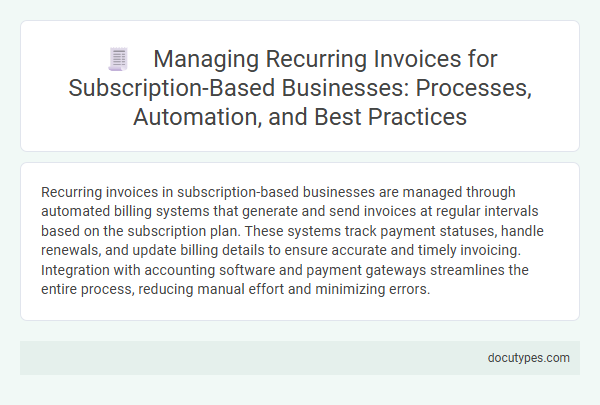Recurring invoices in subscription-based businesses are managed through automated billing systems that generate and send invoices at regular intervals based on the subscription plan. These systems track payment statuses, handle renewals, and update billing details to ensure accurate and timely invoicing. Integration with accounting software and payment gateways streamlines the entire process, reducing manual effort and minimizing errors.
Introduction to Recurring Invoices in Subscription Businesses
Recurring invoices are a fundamental component of subscription-based businesses, ensuring consistent revenue flow through automated billing cycles. These invoices are generated at regular intervals, reflecting the subscription terms agreed upon by the customer and the provider.
Managing recurring invoices involves tracking payment schedules, updating customer information, and handling renewals or cancellations efficiently. Subscription-based businesses rely on specialized invoicing software to automate these processes, minimizing errors and improving cash flow management.
Key Components of a Recurring Invoice
Recurring invoices are essential for subscription-based businesses to ensure consistent billing and revenue flow. They automate the process of charging customers regularly without manual intervention.
- Billing Schedule - Defines how frequently invoices are generated, such as monthly or annually.
- Invoice Amount - Specifies the fixed or variable price associated with the subscription services.
- Customer Details - Includes your customer's contact and payment information for accurate invoicing and payment processing.
Setting Up Automated Billing Cycles
| Aspect | Description |
|---|---|
| Automated Billing Cycle Setup | Recurring invoices are managed by configuring automated billing cycles within the subscription management system. Billing frequency options include weekly, monthly, quarterly, or annual intervals. This setup ensures invoices are generated and sent automatically without manual intervention. |
| Subscription Plan Integration | Each subscription plan is linked with a billing cycle that triggers invoice creation based on the plan's terms. The integration guarantees consistent billing aligned with service delivery schedules. |
| Payment Method Storage | Secure storage of customer's payment details allows for seamless processing of recurring payments. Systems often support multiple payment options such as credit cards, ACH, or digital wallets. |
| Invoice Customization | Invoices can be customized to display customer information, billing periods, itemized services, taxes, and discounts. Clear invoice presentation improves transparency and reduces payment disputes. |
| Notifications and Reminders | Automated email notifications alert customers before billing dates, and reminders are sent for overdue payments. These communications facilitate timely payments and minimize revenue delays. |
| Revenue Recognition Compliance | Automated billing systems incorporate revenue recognition rules to align invoicing with accounting standards. This ensures accurate financial reporting for subscription-based revenue streams. |
| Customer Portal Access | You can allow customers to view, download, or manage their recurring invoices via a secure portal. This empowers customers to stay informed about their billing history and upcoming charges. |
Essential Tools for Recurring Invoice Management
Managing recurring invoices efficiently is crucial for subscription-based businesses to ensure consistent cash flow and customer satisfaction. Essential tools streamline the billing process and reduce errors in recurring invoice management.
- Automated Billing Software - Automates invoice generation and payment reminders to minimize manual work and improve accuracy.
- Subscription Management Platforms - Track customer subscriptions, plan changes, and billing cycles in a centralized system.
- Payment Gateway Integration - Enables secure and seamless payment processing for recurring transactions.
You can leverage these tools to simplify your recurring invoice management and maintain reliable revenue streams.
Integrating Payment Gateways for Seamless Transactions
Recurring invoices in subscription-based businesses are managed through automated billing systems that generate invoices at regular intervals. These systems rely on accurate subscription data to ensure timely and consistent invoicing.
Integrating payment gateways facilitates seamless transactions by enabling automatic payment processing directly from the customer's preferred payment method. This integration reduces manual intervention, minimizes payment delays, and improves cash flow management. Your customers experience a smooth and reliable billing process, enhancing overall satisfaction and retention.
Reducing Errors and Disputes in Recurring Billing
Recurring invoices in subscription-based businesses are managed through automated billing systems that schedule and generate invoices at regular intervals. These systems reduce errors by ensuring consistent application of pricing, discounts, and taxes, minimizing manual entry mistakes. Clear, accurate invoices help your customers understand charges, significantly decreasing disputes and improving payment reliability.
Handling Failed Payments and Dunning Processes
Recurring invoices in subscription-based businesses are managed using automated billing systems that generate invoices at predefined intervals. Handling failed payments involves retry mechanisms and notifying customers promptly to prevent service disruption. Effective dunning processes include sending reminder emails, applying late fees, and offering flexible payment options to recover outstanding balances efficiently.
Compliance and Security Considerations for Invoicing
Recurring invoices in subscription-based businesses require strict compliance with financial regulations to ensure accurate and transparent billing. Companies must adhere to local tax laws and data protection standards to avoid legal penalties and maintain customer trust.
Secure invoicing involves encrypting payment data and implementing access controls to protect sensitive information from unauthorized access. Your business should use automated systems that regularly audit invoices to enhance security and ensure compliance with industry standards.
Best Practices for Customer Communication and Transparency
Managing recurring invoices efficiently is crucial for subscription-based businesses to maintain customer trust and reduce payment disputes. Clear communication and transparency regarding billing cycles help improve customer satisfaction and retention.
- Send timely invoice notifications - Inform customers before each billing cycle with detailed invoice summaries to prevent surprises and build trust.
- Provide accessible billing information - Ensure customers can easily view, download, and manage their invoices through a secure online portal.
- Disclose all fees and changes upfront - Communicate any price adjustments or additional charges well in advance to maintain transparency and avoid confusion.
How Are Recurring Invoices Managed in Subscription-Based Businesses? Infographic

